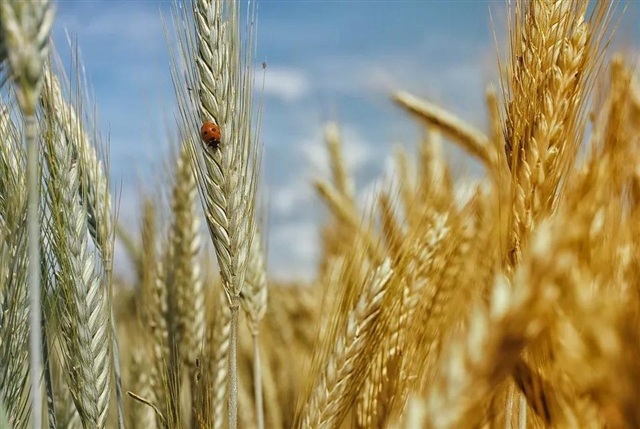|
|
|
|
|
小麦基因编辑新突破:适用于农杆菌转化的CRISPR/Cas9打靶载体 |
|
|
论文标题:Targeted mutagenesis using the Agrobacterium tumefaciens-mediated CRISPR-Cas9 system in common wheat
期刊:BMC Plant Biology
作者:Shujuan Zhang†, Rongzhi Zhang†, Guoqi Song, Jie Gao, Wei Li, Xiaodong Han, Mingli Chen, Yulian Li and Genying Li
发表时间:2018/11/26
数字识别码:10.1186/s12870-018-1496-x
原文链接:https://bmcplantbiol.biomedcentral.com/articles/10.1186/s12870-018-1496-x?utm_source=other&utm_medium=other&utm_content=null&utm_campaign=BSCN_2_DD_Paper_SciNet
微信链接:https://mp.weixin.qq.com/s/xZHAHh0lq0T4InOfumXtYA
2018年11月26日,由山东省农业科学院作物研究所的李根英博士领衔的小麦分子育种团队在BMC Plant Biology上发表了题为“Targeted mutagenesis using the Agrobacterium tumefaciens-mediated CRISPR-Cas9 system in common wheat”的研究论文。
该论文也收录在BMC Plant Biology“植物基因编辑”主题特辑中。

基因的定向突变或调控是作物功能基因组学研究和种质资源创新的重要手段,在三大粮食作物中,水稻、玉米的基因编辑效率已经达到90%以上,相比之下,已经报道的小麦基因编辑效率远远低于水稻和玉米,不到10%。高效的基因编辑不仅仅需要高效的打靶载体,还需要高效的基因转化技术将打靶载体送入细胞内部,因此,高效的打靶载体和基因转化方法决定着后续的基因编辑效率。目前报道的小麦基因编辑事件都是利用基因枪转化或原生质体侵染的方法获得的,其DNA双链的断裂主要依靠载体中gRNA和Cas9酶的瞬间表达来完成,载体系统整合到小麦基因组中的几率很低,这可能是小麦基因编辑效率远远低于水稻、玉米的一个重要原因。
本研究通过启动子元件的改造和组装,构建了适用于农杆菌转化的CRISPR/Cas9打靶载体,选择两个胚乳特异表达基因(籽粒硬度基因pinb和淀粉颗粒结合酶基因waxy)和组成型表达基因(籽粒大小相关基因DA1)作为目标基因,在利用原生质体转化验证载体系统有效性的基础上,通过农杆菌侵染将打靶载体转入普通小麦Fielder,基因转化效率达到80%,进一步检测T0代再生植株的目标基因突变情况,发现组成型表达基因DA1的打靶效率最高达到了54.17%,实现了小麦基因编辑技术的新突破。目前,利用该技术体系已经完成了十几个基因的高效打靶,基因编辑突变体在后代中的遗传和变化规律研究也已经完成,这些研究结果将为小麦功能基因组学研究和目标基因的大规模精准改良提供强有力的技术和工具支撑。
该研究由山东省农业科学院作物研究所的李根英博士领衔的小麦分子育种团队完成,结果发表在11月26日出版的BMC Plant Biology上,该团队的张淑娟、张荣志博士为共同第一作者,李根英和李玉莲博士为共同通讯作者。
摘要:
Background
Recently, the CRISPR/Cas9 system has been widely used to precisely edit plant genomes. Due to the difficulty in Agrobacterium-mediated genetic transformation of wheat, the reported applications in CRISPR/Cas9 system were all based on the biolistic transformation.
Results
In the present study, we efficiently applied targeted mutagenesis in common wheat (Triticum aestivum L.) protoplasts and transgenic T0 plants using the CRISPR/Cas9 system delivered via Agrobacterium tumefaciens. Seven target sites in three genes (Pinb, waxy and DA1) were selected to construct individual expression vectors. The activities of the sgRNAs were evaluated by transforming the constructed vectors into wheat protoplasts. Mutations in the targets were detected by Illumina sequencing. Genome editing, including insertions or deletions at the target sites, was found in the wheat protoplast cells. The highest mutation efficiency was 6.8% in the DA1 gene. The CRISPR/Cas9 binary vector targeting the DA1 gene was then transformed into common wheat plants by Agrobacterium tumefaciens-mediated transformation, resulting in efficient target gene editing in the T0 generation. Thirteen mutant lines were generated, and the mutation efficiency was 54.17%. Mutations were found in the A and B genomes of the transgenic plants but not in the D genome. In addition, off-target mutations were not detected in regions that were highly homologous to the sgRNA sequences.
Conclusions
Our results showed that our Agrobacterium-mediated CRISPR/Cas9 system can be used for targeted mutations and facilitated wheat genetic improvement.
阅读论文全文请访问:
https://bmcplantbiol.biomedcentral.com/articles/10.1186/s12870-018-1496-x?utm_source=other&utm_medium=other&utm_content=null&utm_campaign=BSCN_2_DD_Paper_SciNet
期刊介绍:
BMC Plant Biology(https://bmcplantbiol.biomedcentral.com/ , 3.93 - 2-year Impact Factor, 4.381 - 5-year Impact Factor) is an open access, peer-reviewed journal that considers articles on all aspects of plant biology, including molecular, cellular, tissue, organ and whole organism research.
来源:科学网
特别声明:本文转载仅仅是出于传播信息的需要,并不意味着代表本网站观点或证实其内容的真实性;如其他媒体、网站或个人从本网站转载使用,须保留本网站注明的“来源”,并自负版权等法律责任;作者如果不希望被转载或者联系转载稿费等事宜,请与我们接洽。